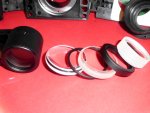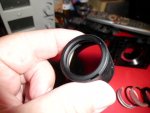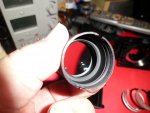OK here's what I'm trying to allude to:
Scale.
I don't offhand know the specs of the G2 lens (it's simply the only small lens I use regularly). But let me make up some phony specs to convey my idea; say that the G2 has a 4mmFL, and it's diameter is 6.5mm. Taking a step back, the raw output of the diode is the same divergence at 1mm from the diode as it is at ten feet based on an inverse square rule. IE at 10mm from diode the raw projected size will be ten times larger than it was at only 1mm, however the fast axis and slow axis still remain in the exact same ratio regardless of distance--without focusing optics used.
Going back to my phony specs assuming a G2 is 4mmFL with 6.5mm diameter (let's assume an NA of 0.6), scaling those values up to a bigger lens would mean that no clipping would occur since the acceptance angle (NA) remains the same and the raw output keeps the same fast and slow axis angles of emission regardless of distance.
Taking that idea directly to use would then mean this:
A lens of (4mm*3)12mmFL and diameter of (6.5mm*3) 19mm with NA of 0.6 means you have a copy of a G2 that is scaled up 3X. This means if no clipping occurred on the G2, then likewise no clipping would occur on the 19.5mm lens. Since the raw output expands at a constant angle across both axis, when it leaves the 19.5mm lens the exit beam will be scaled up 3X in size, but divergence will be 1/3 of the G2. This is the very principle of expansion; expansion is really just the use of a longer system focal lens with diameter that will not clip.
In conclusion, a good laser lens will in fact duplicate the expander output solely based on focal length being longer per scale, and a scaled up aperture so clipping won't occur.
Each diode has a critical lens NA value required not to clip based on raw output. If the fast axis expands at a rate of -20°/+20° from optical center, that means that any lens with a minimal NA of 0.36--which has a max acceptance angle of ~42°, will never clip. Again this is just assuming the diode has a full angle of ~40° on fast axis, though it maybe be less or more than that.
So to wrap it all up, the 12mmFL x 19.5mm diameter lens will "see" the same input of the smaller lens, but the beam will exit at 3X the size, with 1/3 the divergence of the smaller lens, also with same exact efficiency as the smaller lens. In essence you have just expanded the beam 3x, without using any more lenses than one in the whole system.
The lens must mimic the smaller lens in aspheric coefficient to truly be a perfect scale. Using any spherical lens would produce rings when focused to a point, so it is crucial to use a laser grade aspheric contour.
But! This whole idea assumes no correction involved. Corrected or not though, the beam is still expanded at 3X over the G2, so even the fast axis will have an angular deduction to 1/3 of the smaller G2 lens. IE, the line size at 90ft will be the same as it would be at 30ft from the smaller lens.
If correction still needs to be used, this changes everything since it would need to accommodate a beam size starting 3x larger.
But take all this with a grain of salt. I'm fairly certain this is how it will always work, but spherical aberration can still plague good lenses, and the G2 has extremely little to no spherical aberration. Might take some trial and error to find a truly good lens output, but the specs when scaling should still always hold true when the lens performs well.
Please do enlighten me if I'm missing the boat somewhere here.












